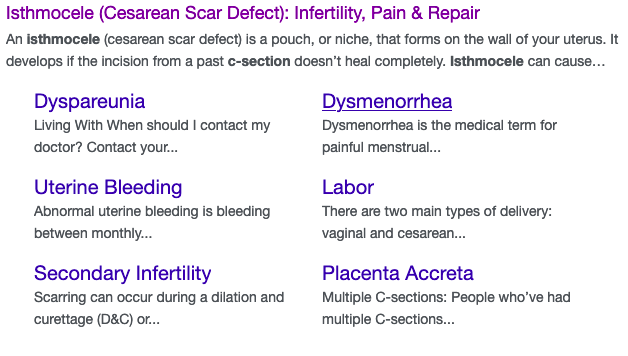Welcome
Isthmocele (pronounce it – CLICK)
Cesarean scar defects (CSDs), i.e. deficient uterine scars following a cesarean section, involve discontinuity at the site of a previous Cesarean section scar. These anatomical defects have been reported to be associated with postmenstrual spotting, chronic pelvic pain and infertility. Few case series have suggested improved fertility (most probably by improving implantation of embryos) The aim of this study is to prospectively record embryonal implantation rate during IVF in patients with CSDs, and to evaluate the effect of hysteroscopic repair of CSDs on fetal implantation during IVF.
How common is CSD ?
The prevalence of CSD is not known, but may be more common than realised. It has been reported amongst 20 to 80% women after 1 or more previous C-Section.
This is a BIG issue – the ignorance of this (CLICK) MAY life disriupoion way more than ‘birth trauma’. May even cause death . . .
Dehiscence – split open of a wound (or pod) CLICK Symptoms CLICK


When should I call my doctor?
An isthmocele is a pouch, or niche, of tissue that forms on the wall of your uterus. It’s the result of a C-section incision that didn’t heal completely. Isthmoceles can lead to abnormal vaginal bleeding, pelvic pain and menstruation problems. It can also cause infertility or problems with future pregnancies. The most common treatment is minimally invasive surgery to remove excess scar tissue and repair the niche. Most people can still have healthy pregnancies after treatment.
If you have an isthmocele while pregnant, you’re at risk for a ruptured uterus. This is a medical emergency. It occurs if the uterine scar separates and your uterus tears open. It can pose serious health risks to you and your baby. Seek medical attention right away if you experience severe pelvic pain, pain at the site of a C-section scar or heavy vaginal bleeding. These could be signs of a ruptured uterus.
This may be behind why placental problems happen (if women get pregnant after C section).
And all the pelvic flow impediments . .
What causes a cesarean scar defect?
A C-section involves two incisions: one in your abdomen and one in your uterus. If the incision in your uterus doesn’t heal completely or you’ve had multiple incisions in the same area, the surrounding tissue becomes thin. It can form a pouch that fills with fluid and blood.
The location of the C-section incision might affect whether you develop a scar defect. An incision that’s too low on your uterus tends to form a larger scar. Low incisions are more common when your c-section happens after you’ve been in labor for a while. A single layer of stitches to close the uterine incision (instead of a double layer) may also make isthmoceles more likely
You may not have heard of this before. .
What is this (CLICK)
Cesarean scar defects (C.S.D.s), i.e. deficient uterine scars following a cesarean section, involve discontinuity at the site of a previous Cesarean section scar. These anatomical defects have been reported to be associated with postmenstrual spotting, chronic pelvic pain and infertility. Few case series have suggested improved fertility (most probably by improving implantation of embryos)
Another surgical study (CLICK) and yet another (CLICK)
See my page Effective Healing After C Section (CLICK)
Here is another page (CLICK)
FERTILITY? (CLICK)
ENDO?
IN PREGNANCY (CLICK)
HOW TO TREAT MEDICALLY? (CLICK)
